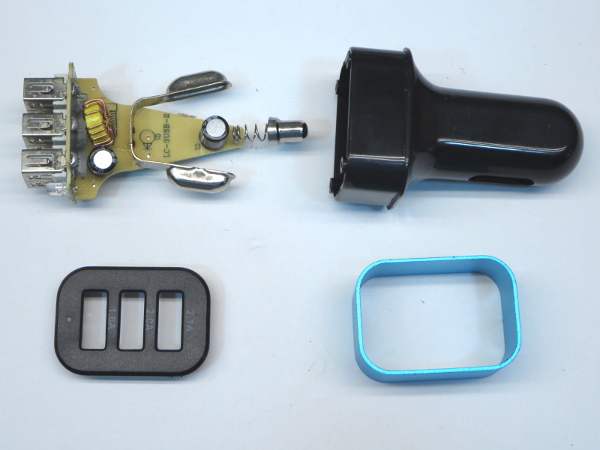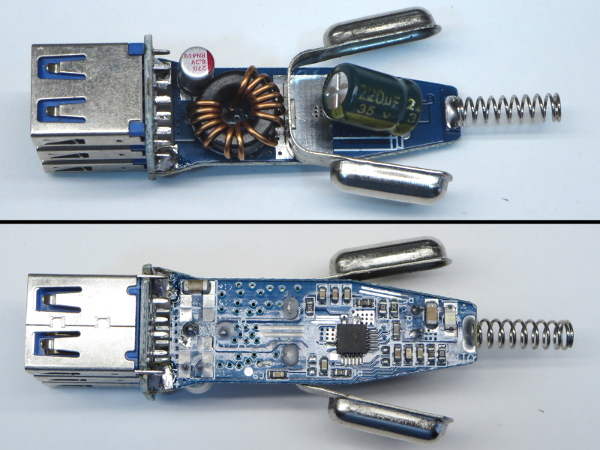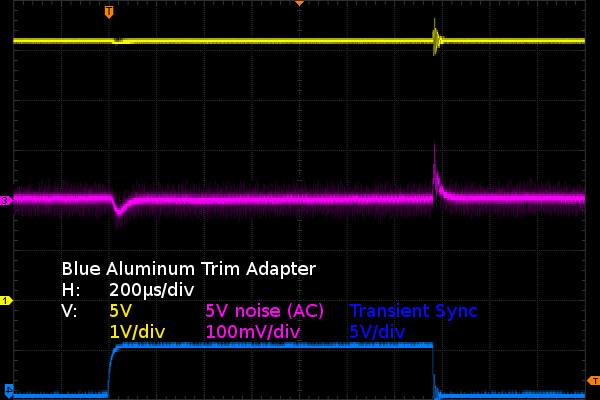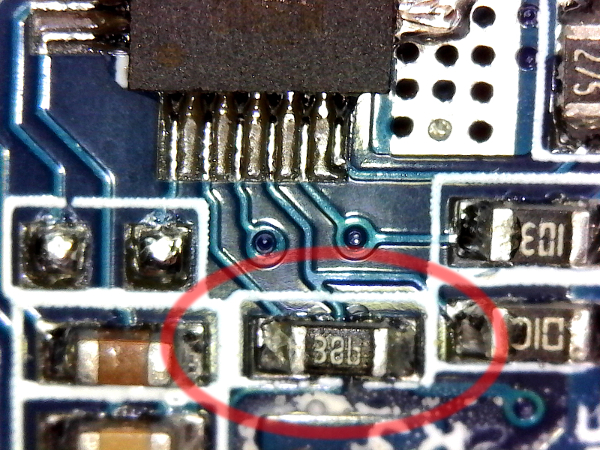10 Inexpensive Automotive USB Adapters Tested -- Are They Any Good?
Third Batch: Anodized Aluminum Club
Are the blue anodized aluminum trim on the nameless unit and golden anodized aluminum cap on the LDNIO adapter an exercise in misplaced priority or a premium cosmetic feature on products that already have their bases covered? Time to pop their caps and pull them out of their plastic skirts.


The blue adapter comes apart by prying its press-fitted face plate off from the body, and then pulling the circuit board out from its injection-molded tube housing. The only thing holding the boards in is the outward force of the barrel ground contacts against the plastic tube where the ground contact cut-outs are. Initial signs look mildly encouraging: we have a toroidal inductor and the ground contacts are well positioned to act as a heat sink. A quick glance at the bottom of the board quickly confirms that this layout indeed uses the ground contacts for soaking up thermal energy. Soldering quality, on the other hand, looks like this surface-mount board was put together by hand using an excessively large soldering iron tip. Many components are poorly aligned and have solder blobs on their pads larger than many components themselves. If you are still searching for a rectifier on that board, you won’t find it. The controller has its own integrated synchronous rectification FET. A 5 mm blue LED hidden behind a small hole in the cap provides power indication.


The golden-capped LDNIO adapter comes apart in much the same way: pop the extremely tight-fitting aluminum cap off, remove the inner plastic retention cap, then pull the board that's held fast by its ground contacts out. On the bottom side of the board, we are greeted by more surface-mount capacitors than nearly all units thus far combined, a bunch of unpopulated capacitor footprints near the USB ports, a GStek regulator in QFN packaging, and what appears to be a surface-mount fuse near the positive contact spring. The top of the board features the bulk bypass capacitors and possibly the largest toroidal inductor we are likely to see in this round-up. Much like the blue one, this one does not (completely) omit to leverage its ground contacts for heat sinking by using via stitching near the chip to pass heat to the large tin-plated area on the top side of the board, sending it on its way to the contacts. This isn't as efficient as a direct pour on the same side as the chip, but for a high-efficiency design, it may be enough. Two tiny white LEDs are tucked away on the sub-PCB hosting the ports, providing discrete power indication. Don’t search for a diode on this implementation either; the regulator has that covered. There is no sign of input over-voltage protection, but aside from that, the LDNIO looks a mile ahead of anything else we've seen. It may very well be able to deliver on that 5.1 A total rating printed on its housing. Do note that I haven’t fished out its regulator’s spec sheet yet, so let’s do that right now and see we're to be disappointed again.
| Header Cell - Column 0 | LDNIO | ‘Blue’ |
|---|---|---|
| Adapter Rating | 5100 mA | 5100 mA |
| Regulator | Gstek GS92A3 | HCW HC8816 |
| Regulator Ratings | 28 V, 8 A, 100-600 kHz, 9.5/18 mΩ NMOS | 27 V, 2.5 A, 340 kHz, 95% max eff. |
| Input capacitor | Changx 35 V, 220 µF | HDS 35 V, 100 µF |
| Output capacitor | ??? 6.3 V, 270 µF | HDS 10 V, 220 µF |
| Rectifier Diode | Integrated synchronous rectifier | Integrated synchronous rectifier |
| Input protection | Fuse | None |
I could not find a proper datasheet for the blue adapter's HCW switching regulator, so I tried to piece together the basic specs from what few listings with conflicting specs I could find. It appears that its switching chip won’t be able to deliver anywhere near the claimed 5.1 A spec. Even the most optimistic specifications I came across claim only 3 A, while the most pessimistic say 2 A. Things look far more promising on the LDNIO’s side, as it appears to sport one mean little switcher; delivering 5.1 A should be a walk in the park. With less than 30 V input ratings, though, I would not trust either of these in a 24 V system. It is almost a shame that the LDNIO adapter lacks input protection. Fortunately, there is a simple work-around for load-dump surges: don’t leave it plugged in between uses, and don’t plug it in until the vehicle is running normally. If the LDNIO does not run circles around the blue adapter, I’ll eat my shorts. The LDNIO’s bulk output capacitor has a Nichicon-style red stripe on it, but with a Changx capacitor on the input, that seems highly unlikely.


Transient and line regulation look as good as any other unit so far, exhibiting the same waveforms as my baseline. Surprisingly enough, despite the LDNIO’s seemingly more aggressive bypassing and high-performance regulator, its output appears to have more noticeable rippling. Magnitude-wise, we are talking less than 50 mVPP, which is nothing worth worrying about. How well do these perform under stress? Table time again.
| Header Cell - Column 0 | Test Current | Blue | LDNIO |
|---|---|---|---|
| Output Voltage | 500 mA | 5.25 V | 5.27 V |
| 1000 mA | 5.25 V | 5.25 V | |
| 2100 mA | Fail (1.8 A @ 5.23 V)Thermal Shutdown | 5.21 V | |
| 3100 mA | - | 5.18 V | |
| 3700 mA | - | 5.16 V | |
| Input Power | 500 mA | 3.173 W(264 mA @ 12.02 V) | 3.029 W(252 mA @ 12.02 V) |
| 1000 mA | 6.002 W(501 mA @ 11.98 V) | 5.691 W(475 mA @ 11.98 V) | |
| 2100 mA | - | 11.769 W(989 mA @ 11.90 V) | |
| 3100 mA | - | 17.286 W(1460 mA @ 11.84 V) | |
| Max sustainable | 11.189 W(941 mA @ 11.89 V) | 20.839 W(1766 mA @ 11.80 V) | |
| Efficiency | 500 mA | 83% | 87% |
| 1000 mA | 87% | 92% | |
| 2100 mA | - | 93% | |
| 3100 mA | - | 93% | |
| Max sustainable | 84% | 92% | |
| Noise (RMS) | 500 mA | 14 mV | 11 mV |
| 1000 mA | 21 mV | 11 mV | |
| 2100 mA | - | 12 mV | |
| 3100 mA | - | 14 mV | |
| Max sustainable | 25 mV @ 1.8 A | 52 mV @ 3.7 A | |
| Cold Current Limit | - | 3200 mA | 17 A |
| Hot Current Limit | - | 2500 mA | 12 A |
| 10-Second Short-Circuit | - | Pass(Thermal shutdown) | Pass, dangerously(10 A continuous) |
Here's another example of how the shape of the noise makes it look worse on the waveform than the actual magnitude. LDNIO’s fuzzier waveform amounts to half the RMS value of the blue adapter's. The LDNIO unit’s noise did eventually pass the 50 mV mark, but how many people will connect enough high-drain devices to get there?
In terms of performance, LDNIO beats the anonymous blue adapter hands-down by more than doubling its output current capability and still going strong. Perhaps too strong. In my initial 10-second short-circuit survival test, my jumper wire and USB cable got very hot from passing that 10 A short-circuit current while the adapter barely warmed up. Its power indication LEDs were still lit and its output was still reading 5.25 V as if I had nothing plugged in. When I attempted the test again by directly shorting my USB cable, the adapter pulled enough current from my 300 W power supply to trip its over-current protection. To get the cold short-circuit figure, I had to get the adapter started on a “baby short” (about 10 A) with my jumper wire and then short my jumper out to cut the load transient in two steps. From the look of it, the LDNIO could have powered my jumper wire until either my jumper, USB cable, or the adapter’s USB port burnt out. At a whopping 17 A, the LDNIO did enter thermal shutdown after a few seconds and its output still read 5.15 V before that happened, meaning that my 17 A figure is either still wiring-limited or barely scratching the chip’s cold current limit. That’s absolutely nuts, and the reason why I say it “passed” my 10-second short-circuit test dangerously. It effectively has no over-current limit to mitigate damage from cable and device shorts. This reminds me of those insane computer power supplies that can deliver over 150 A on a single 12V rail. If you have anything less than a hard short to ground on a single 12 V wire (so the wire does not have time to warm up before the PSU trips), the power supply will merrily smoke it without skipping a beat.
Get Tom's Hardware's best news and in-depth reviews, straight to your inbox.
The GS923A regulator used in the LDNIO does have facilities for a programmable current limit on pin #2, and that limit should be set to something sensible like 6 A. In this application, that current limit setting resistor circled in red reads “386” or 3.8 MΩ. Plug this in the manufacturer’s IL_LIM = 20 µA * RCS / RDSL formula where the low-side drain-source resistance (RDSL) is 9.5 mΩ and you get an 8000 A current limit. I believe we can safely conclude that someone goofed up and loaded a reel of 386 (3.8 MΩ) resistors on the pick-and-place machine instead of the intended reel of 383 (3.8 kΩ) resistors, effectively disabling the current limit protection. I will need to put some ~3 kΩ 0402 resistors on my next parts order to fix this at some point in the future.
There you have it. One adapter with flashy blue anodized trim grossly under-delivers by using a chip clearly incapable of meeting the product's lofty ratings, and another with an eye-catching golden anodized cap is capable of delivering far too much unrestrained current for any device’s good. It's common to lambast hardware that under-delivers. But how often do you see components getting chastised for over-delivering? The LDNIO is one of those exceptional cases.
Current page: Third Batch: Anodized Aluminum Club
Prev Page Second Batch: Bigger Bullet Duo Next Page Fourth Batch: The Blind Bag-
SpAwNtoHell Tho have the knoledge to test all of that myself i never bothered as my intuition always pointed that generic are beter next to nothing only. Genuine branded is what i always used for the all explained and revealed in your article; like samsung charger, htc charger and so on... and i always used 12 spliters... with the incovenience of the space...Reply -
Math Geek very interesting read. never thought it through this much but always assumed the $1 adapters were junk and generally bought name brand adapters for around $10 or so.Reply
but now i wonder and almost feel like taking one apart just to see what's inside. :) -
Daniel Sauvageau Reply18542197 said:No Anker in the review is a bummer, still, thanks for doing this!
At least one of Anker's Amazon listings has a 3D render showing the internals. At a glance, it seems quite similar to the LDNIO.18542229 said:but now i wonder and almost feel like taking one apart just to see what's inside. :)
If I do another one of these roundups, I'll try to get my hands on one. -
Math Geek i have a couple of the belkin and griffin brands in my cars. they are common adapters found at walmart for $10-15 depending on the model. seems like a decent trade off form the super cheap ones and the super expensive ones.Reply
but now you got the topic started, i wonder if they are worth the price and better than the junk ones i avoided. -
Daniel Sauvageau Well, throw adapter models/brands at me and I'll look around to see which ones I can grab for a reasonable price for Round 2.Reply -
Math Geek my next trip to walmart/target i'll make some notes. they carry roughly the same type stuff as best buy as far as brands go. will look for the midrange models i'd likely buy and post some for you :)Reply -
turkey3_scratch All of these have really high ripple. The ATX spec alone (and I know these don't have to follow that) defines 50mv max for the 5VSB rail. These all chill above 100mv.Reply
